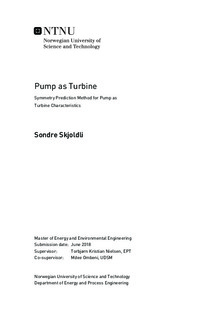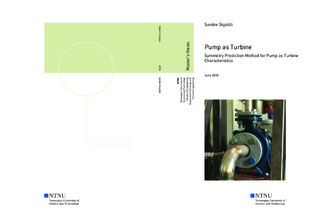| dc.description.abstract | As a cheap and available source of renewable energy, regular centrifugal pumps may be run in reverse to act as hydro turbines. Pumps as turbines (PAT) are especially relevant for isolated rural areas, or in developing countries, where efficiency is not necessarily the highest priority. The main challenge, however, is to be able to pick a suitable pump for a given site, which coincides with the available head and discharge. In order to make this decision, one has to be able to predict how a certain pump will perform as a turbine. A lot of work has been done in the past to establish such prediction methods, based on tests and empirical correlations. Many of these methods only predict one optimal point of operation, but as pumps do not have any guide vanes, it will be difficult to constantly operate a PAT at this specific point. Therefore, this may be insufficient. With this in mind, and because of the inaccuracies of these methods, a new approach has been suggested - an approach in which full head-flow characteristics are predicted based solely on the pump's impeller geometry.
By assuming symmetry in the velocity diagrams of pump and turbine operation, a method for establishing the PAT characteristic was made. For validation purposes, this method was applied to one specific pump. Experimental results revealed a slight asymmetry, and shortcomings in the initial assumptions. Therefore, the model was modified thereafter, with the introduction of an empirical constant. The predicted characteristic lacks some accuracy in comparison to the real PAT characteristic found through testing, but its optimal point of operation is in line with previous established prediction methods. Still, the modifications, and the empirical constant, may be enhanced further through comprehensive testing of numerous pumps, of various type. | |

